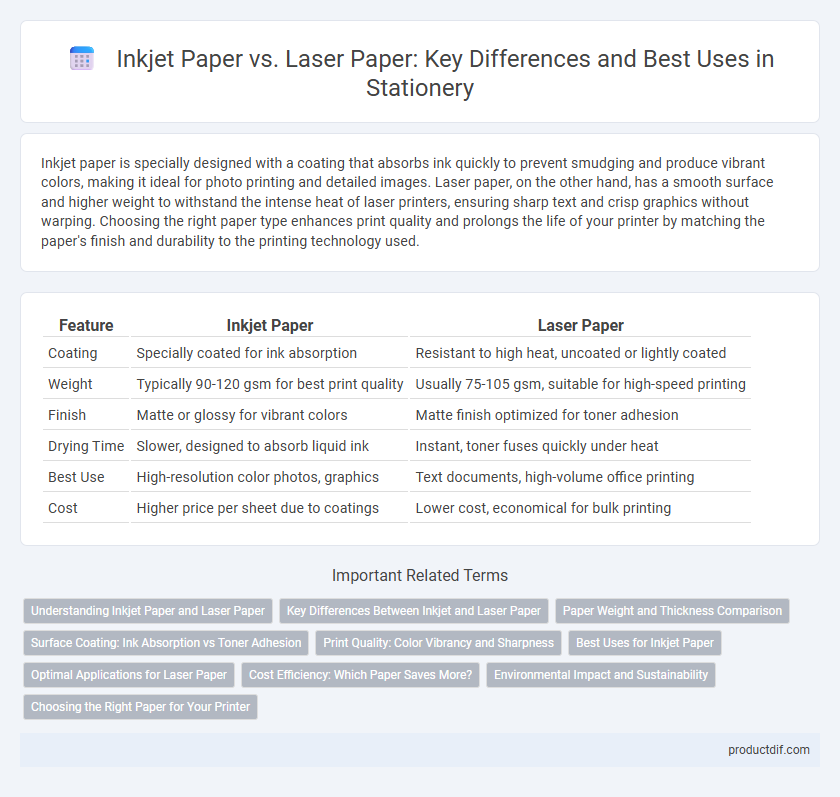Inkjet paper is specially designed with a coating that absorbs ink quickly to prevent smudging and produce vibrant colors, making it ideal for photo printing and detailed images. Laser paper, on the other hand, has a smooth surface and higher weight to withstand the intense heat of laser printers, ensuring sharp text and crisp graphics without warping. Choosing the right paper type enhances print quality and prolongs the life of your printer by matching the paper's finish and durability to the printing technology used.
Table of Comparison
| Feature | Inkjet Paper | Laser Paper |
|---|---|---|
| Coating | Specially coated for ink absorption | Resistant to high heat, uncoated or lightly coated |
| Weight | Typically 90-120 gsm for best print quality | Usually 75-105 gsm, suitable for high-speed printing |
| Finish | Matte or glossy for vibrant colors | Matte finish optimized for toner adhesion |
| Drying Time | Slower, designed to absorb liquid ink | Instant, toner fuses quickly under heat |
| Best Use | High-resolution color photos, graphics | Text documents, high-volume office printing |
| Cost | Higher price per sheet due to coatings | Lower cost, economical for bulk printing |
Understanding Inkjet Paper and Laser Paper
Inkjet paper is specifically designed to absorb liquid ink, preventing smudging and ensuring vibrant color reproduction for inkjet printers. Laser paper features a smooth, heat-resistant coating that withstands the high temperatures of laser printers, producing sharp, precise text and images without curling or jamming. Understanding the properties of inkjet and laser papers helps optimize print quality and prevent printer damage.
Key Differences Between Inkjet and Laser Paper
Inkjet paper is specially coated to absorb liquid ink, preventing smudging and enhancing color vibrancy, making it ideal for photo printing and detailed graphics. In contrast, laser paper is designed with a smooth, heat-resistant surface optimized for toner adhesion, ensuring sharp text and images without warping during the fusing process. Choosing the correct paper type is crucial for print quality, with inkjet paper generally thicker and more textured, while laser paper tends to be lighter and smoother.
Paper Weight and Thickness Comparison
Inkjet paper typically ranges from 90 to 120 gsm, offering a smoother surface designed to absorb liquid ink effectively, while laser paper usually falls between 70 to 100 gsm, engineered to withstand high temperatures and toner adhesion. Thickness in inkjet paper varies from 100 to 160 microns, providing durability for vibrant inkjet prints, whereas laser paper thickness generally spans 90 to 140 microns to endure the heat and pressure of laser printing processes. Choosing between these papers depends on print requirements, with inkjet paper optimized for color vibrancy and laser paper designed for crisp text and fast drying.
Surface Coating: Ink Absorption vs Toner Adhesion
Inkjet paper features a porous surface coating designed to enhance ink absorption, preventing smudging and ensuring vibrant color output ideal for photo prints. Laser paper has a smooth, heat-resistant coating that promotes toner adhesion during the fusing process, resulting in crisp, sharp text and images. Choosing the appropriate surface coating optimizes print quality and durability based on the printing technology used.
Print Quality: Color Vibrancy and Sharpness
Inkjet paper is engineered with a coating that absorbs ink, enhancing color vibrancy and producing sharper, more detailed images ideal for photo-quality prints. Laser paper is designed to withstand high heat from laser printers, offering crisp text and sharp graphics but with less color saturation compared to inkjet paper. Choosing the right paper based on printer type significantly impacts print quality, especially in color-rich, detailed documents.
Best Uses for Inkjet Paper
Inkjet paper is specially designed to absorb liquid ink, producing vivid colors and sharp details ideal for photo printing, art projects, and high-quality document prints. Its smooth surface and coating enhance color accuracy and prevent ink bleeding, making it perfect for printing images and graphics with precise detail. Unlike laser paper, inkjet paper is best for applications requiring rich color reproduction and smooth image output.
Optimal Applications for Laser Paper
Laser paper is specifically designed to withstand the high heat and pressure of laser printers, ensuring crisp text and sharp images without smudging or curling. Its smooth surface optimizes toner adhesion, making it ideal for professional documents, reports, and presentations requiring high-quality print output. For durability and precision in high-volume printing environments, laser paper offers superior performance compared to inkjet paper.
Cost Efficiency: Which Paper Saves More?
Inkjet paper generally costs less per sheet but requires more frequent replacement due to lower durability compared to laser paper. Laser paper, though pricier upfront, offers higher resistance to heat and toner adhesion, reducing waste and reprints over time. For businesses with heavy printing needs, laser paper's durability often results in greater overall cost efficiency despite the higher initial expense.
Environmental Impact and Sustainability
Inkjet paper often contains coatings that may hinder recycling and contribute to environmental waste, whereas laser paper is typically designed for higher recyclability and durability, reducing its ecological footprint. The manufacturing of laser paper generally uses fewer chemicals, minimizing harmful emissions compared to the production of inkjet paper. Choosing laser paper supports sustainability efforts by promoting resource efficiency and lowering landfill contributions in office and printing environments.
Choosing the Right Paper for Your Printer
Inkjet paper features a highly absorbent coating designed to hold liquid ink, ensuring vibrant colors and sharp details ideal for photo printing and detailed graphics. Laser paper, made to withstand high heat from laser printers, offers a smooth surface that prevents toner from smudging and provides crisp text output. Selecting the appropriate paper based on your printer type enhances print quality and prevents paper jams or toner issues.
Inkjet Paper vs Laser Paper Infographic

 productdif.com
productdif.com